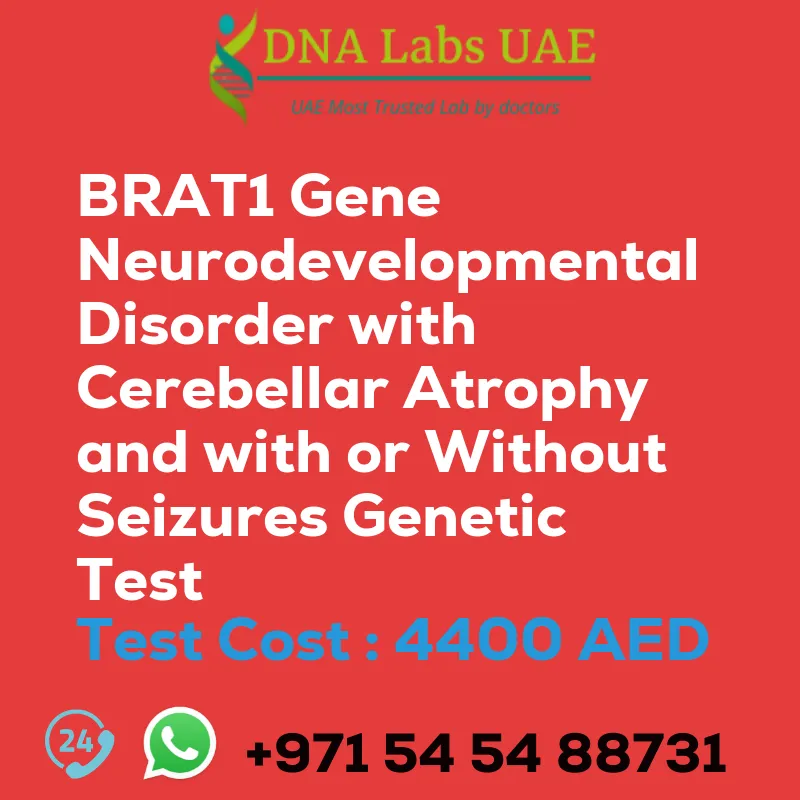BRAT1 Gene Neurodevelopmental Disorder with Cerebellar Atrophy and Seizures Genetic Test
Genetic testing plays a crucial role in diagnosing and managing various disorders. One such disorder is the BRAT1 Gene Neurodevelopmental Disorder with Cerebellar Atrophy and Seizures. This blog will provide detailed information about this genetic test, including its cost, symptoms, diagnosis, and more.
Test Name: BRAT1 Gene Neurodevelopmental Disorder with Cerebellar Atrophy and Seizures Genetic Test
Test Components:
- Price: 4400.0 AED
- Sample Condition: Blood or Extracted DNA or One drop Blood on FTA Card
- Report Delivery: 3 to 4 Weeks
- Method: NGS Technology
- Test Type: Neurological Disorders
- Doctor: Neurologist
- Test Department: Genetics
Pre Test Information:
Before undergoing the BRAT1 Gene Neurodevelopmental Disorder with Cerebellar Atrophy and Seizures Genetic Test, it is important to provide the clinical history of the patient. Additionally, a genetic counseling session is recommended to draw a pedigree chart of family members affected by this disorder.
Test Details:
The BRAT1 gene is associated with a neurodevelopmental disorder characterized by cerebellar atrophy and seizures. To confirm a diagnosis, a Next-Generation Sequencing (NGS) genetic test is performed. NGS is a high-throughput sequencing technology that allows for the simultaneous analysis of multiple genes.
In the case of the BRAT1 gene, the NGS test involves sequencing the entire coding region of the gene to identify any pathogenic variants or mutations. The test requires a blood or saliva sample from the individual being tested. The DNA is extracted from the sample and then sequenced using NGS technology.
The resulting sequence data is analyzed to identify any variants or mutations in the BRAT1 gene. If a pathogenic variant or mutation is identified, it confirms a diagnosis of the neurodevelopmental disorder with cerebellar atrophy and seizures. This information is crucial in guiding treatment and management strategies for the individual.
It is important to note that NGS testing may not always identify a pathogenic variant or mutation, as not all genetic causes of a disorder may be known or included in the test panel. Therefore, genetic testing should always be interpreted by a healthcare professional with expertise in genetics to ensure accurate diagnosis and appropriate management.
Overall, the BRAT1 Gene Neurodevelopmental Disorder with Cerebellar Atrophy and Seizures Genetic Test is a valuable tool in diagnosing and managing this specific disorder. By understanding the genetic basis of the condition, healthcare professionals can provide personalized care and support to individuals affected by this disorder.
| Test Name | BRAT1 Gene Neurodevelopmental disorder with cerebellar atrophy and with or without seizures Genetic Test |
|---|---|
| Components | |
| Price | 4400.0 AED |
| Sample Condition | Blood or Extracted DNA or One drop Blood on FTA Card o |
| Report Delivery | 3 to 4 Weeks |
| Method | NGS Technology |
| Test type | Neurological Disorders |
| Doctor | Neurologist |
| Test Department: | Genetics |
| Pre Test Information | Clinical History of Patient who is going for BRAT1 Gene Neurodevelopmental disorder with cerebellar atrophy and with or without seizures NGS Genetic DNA Test A Genetic Counselling session to draw a pedigree chart of family members affected with BRAT1 Gene Neurodevelopmental disorder with cerebellar atrophy and with or without seizures |
| Test Details |
The BRAT1 gene is associated with a neurodevelopmental disorder characterized by cerebellar atrophy and seizures. To confirm a diagnosis, a Next-Generation Sequencing (NGS) genetic test can be performed. NGS is a high-throughput sequencing technology that allows for the simultaneous analysis of multiple genes. In the case of the BRAT1 gene, the NGS test would involve sequencing the entire coding region of the gene to identify any pathogenic variants or mutations. The test requires a blood or saliva sample from the individual being tested. The DNA is extracted from the sample and then sequenced using NGS technology. The resulting sequence data is analyzed to identify any variants or mutations in the BRAT1 gene. If a pathogenic variant or mutation is identified in the BRAT1 gene, it can confirm a diagnosis of the neurodevelopmental disorder with cerebellar atrophy and seizures. This information can be used to guide treatment and management strategies for the individual. It’s important to note that NGS testing may not always identify a pathogenic variant or mutation, as not all genetic causes of a disorder may be known or included in the test panel. Additionally, genetic testing should always be interpreted by a healthcare professional with expertise in genetics to ensure accurate diagnosis and appropriate management. |








